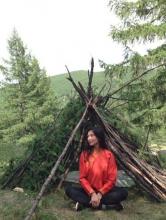In a large country of only 3 million people (where wild horses outnumber people), with an estimated 2 million who live in the capital and 1 million who live a traditional nomadic lifestyle, traditional skin care and beauty practices can still be found.
In the capital city of Ulaanbaatar, women practice many of the same beauty regimens as those of women in other parts of mainstream Asia, with access to department store beauty counters and shopping malls found in major cities throughout the world. With the influx of movies and media into Mongolia from South Korea in the late 1990s, South Korean beauty regimens and standards have weaved their way into the urban culture. However, in rural Mongolia, where a nomadic way of life still predominates, certain beauty and cultural practices remain intact without the influence of mainstream culture.
While lucky enough to travel to rural Mongolia on a medical volunteer trip this summer, I was able to witness and inquire about some of these practices. I was extremely fortunate to meet and befriend a Mongolian woman, Tuvdendorj Dulguun, who shared some of these skin care secrets with me.Homemade yogurt, a staple in rural Mongolia, is used on the face to help brighten the skin. In rural Mongolia, the yogurt is made and eaten fresh, thus lasts for 1-2 days if not refrigerated. The yogurt comes from cows and goats (rarely from other animals) that graze on open land without pesticides and are not fed hormones and grains. My personal diet doesn’t consist of much dairy, but I can say firsthand that in my opinion, it is delicious there. Yogurt is also applied to the skin to treat acne, but for acne the yogurt is fermented more than usual, so there is more acid to reduce the skin inflammation. (Lactic acid is typically what is found in fermented yogurt.)
Another secret is the use of sheep tail fat on the skin. A well fed sheep collects and stores a large amount of fat in the lower back and tail as an energy reserve – easily recognizable as a “fat bottom” on the animal. A mutton (older sheep only), when consumed, is typically prepared for special occasions, such as the new year’s festival “Tsagaan Sar” or a wedding. Sheep tail fat is thought to have more collagen and provide more moisturization than other beauty products, especially in the sometimes harsh, arid climate of Mongolia. This tradition is fading, but Tuvdendorj’s aunt still uses it and has beautiful skin. The fat in the sheep’s tail is full of nutrients, and is what’s used for human skin. Healthy fats have omega-3 fatty acids, which are anti-inflammatory, and contain essential fatty acids plus fat soluble vitamins – A, D, E, and K – which can be helpful for skin. Grass fed-animals tend to have more omega-3 fatty acids, whereas grain-fed animals tend to have more omega-6 than omega-3 fatty acids.Headdresses, traditional clothing, and adornments are seen in traditional Mongolia, particularly during the Naadam festival. With naturally high cheek bones and oval eyes that have epicanthic folds, many Mongolian women have distinct features. Long black braided hair is seen as an adornment during festivals. In rural Mongolia, it is not uncommon to see rosy red cheeks, flushed with telangiectasias due to sun, wind, and snow. In the capital city, the distinctive telangiectatic cheeks are not seen as frequently; instead, many women wear eyeliner to highlight their oval eyes. With my mother’s side of the family being direct descendants of Mongolia to the Middle East, I found these beauty practices to be fascinating and they hold a special place in my heart.
Dr. Wesley and Dr. Talakoub are co-contributors to this column. Dr. Wesley practices dermatology in Beverly Hills, Calif. Dr. Talakoub is in private practice in McLean, Va. This month’s column is by Dr. Wesley. Write to them at dermnews@frontlinemedcom.com. They had no relevant disclosures.




